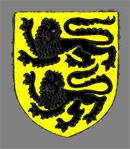The Manor of Flitwick
Volume II of the Victoria County History for Bedfordshire was published in 1908 and contains details on all the manors in Flitwick. William Lovet had five hides in Flitwick in 1086. The overlordship of manor seems to have passed to the Earls of Albermarle since in the late 12th century was held by Hawise, Countess of Albermarle in her own right. The Earls of Albermarle held the overlordship until the end of the 13th century. By 1346 the overlordship was held by John de Lyle. His son Robert alienated his right in Flitwick to the Crown in 1368 which gave it John de Wahull who died in 1370. In 1414 the overlord was Nicholas Borus.
The first know tenant of the manor is Philip de Sanvill who granted large amounts of land in Flitwick to Dunstable Priory in the reign of Henry II (1154-1189). His granddaughter Osmunda married William, son of Fulcher and their daughter Amabel married David Rufus de Flitwick.

The Flitwick family arms
David Rufus de Flitwick died in 1247 and was succeeded by David de Flitwick. The de Flitwick family then held the manor into the second half of the 14th century. Eleanor de Flitwick married John Goderiche and they conveyed the manor to Sir John de Clynton and his wife with a reversion to themselves but in 1381 sold the reversion to Ralph Crophill. In the event the manor was held by trustees until 1429 when it was alienated to John Cornwall, 1st Baron Fanhope, who also acquired Ampthill Manor. On his death in 1443 the manor was claimed by both Ralph, 3rd Baron Cromwell and Henry Holland, 3rd Duke of Exeter. The case was arbitrated by Thomas Bourchier, probably in favour of the duke, who forfeited his property on the accession of his enemy Edward IV in 1461 (1461-1470 and 1471 to 1483).

The de Grey family arms
In 1461 Edward granted Flitwick Manor to Sir Edmund Grey, who had turned-coat to Edward’s side at the Battle of Northampton. In gratitude Grey was created 1st Earl of Kent. Richard, 3rd Earl of Kent, sold the manor in 1508 due to his debts. After his death in 1524 his half-brother Sir Henry Grey (he refused to take the title Earl of Kent due to the parlous nature of the family coffers) retrieved the manor and alienated it to Richard Wingfield, Henry Wyat and Richard Weston, from whom it passed to the Crown and in 1542 the manor was annexed to the Honour of Ampthill.
In 1617 the Crown granted a lease of the manor to Sir Francis Bacon and others for 99 years, the interest in which they transferred in 1628 to William Williams and others. The reversion was settled on Edward Ditchfield and John Highlord, trustees for the City of London “by whom the estate was doubtless sold in small portions and the manorial rights thus dispersed”.